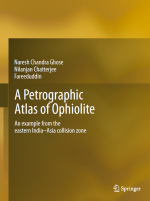Добрый день, Коллеги. Важное сообщение, просьба принять участие. Музей Ферсмана ищет помощь для реставрационных работ в помещении. Подробности по ссылке
A Petrographic atlas of ophiolites. An example from the eastern India-Asia collision zone / Петрографический атлас офиолитов. Пример из восточной Индо-Азиатской коллизионной зоны
The basic tenet of the plate tectonic paradigm is that a newly generated oceanic plate is subducted at a trench. However, it is widely accepted today that some material is not subducted, but is accreted to form an accretionary wedge or prism, within which there may be a preserved section of the oceanic crust/mantle, known as an ophiolite. And many detailed studies now reveal that there are many types of ophiolites that may have formed, in e.g. a mid-oceanic ridge, close to a continental margin, and (the majority) in a suprasubduction zone. Ophiolites commonly retain evidence of the low-temperature conditions of the ocean floor, and a few are closely associated with blueschists and eclogites, the metamorphic petrology of which provides information on the depths to which the material was subducted and exhumed. An associated accretionary wedge may contain relicts of ocean plate stratigraphy that records the travel history of the ocean floor as it moved laterally from ridge to trench. Most important are structures (e.g. extensional faults, thrusts, folds, lineations, kinematic indicators and S-C fabrics), which can only be obtained from detailed field work that will tell us if the ophiolite was rooted, for example in a ridge or an oceanic transform fault, and if it went through transpressional or orthogonal shear during accretion <...>




